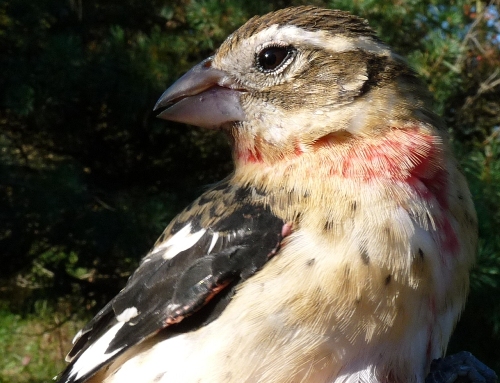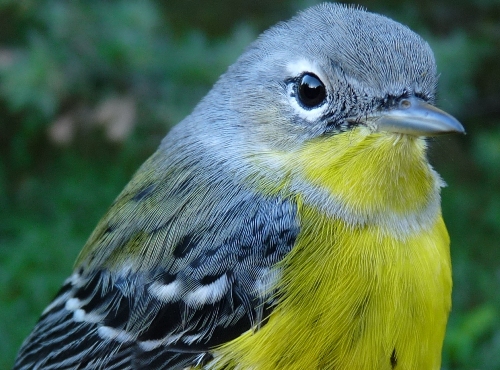|
Week 8: September 19 - 25, 2009 |
Welcome
to the McGill Bird Observatory weekly report.
Click here for a complete listing of our archives.
Comments or
questions are welcome at "mbo AT migrationresearch.org".
|
PICTURE
OF THE WEEK: |
|

As the season advances, we continue to welcome later migrants arriving at MBO for.
the first time this fall. Among them this week was this
Golden-crowned Kinglet,
an early individual in advance of our expected early October influx of them and their
even more numerous cousins, Ruby-crowned Kinglets.
(Photo by Simon Duval)

|
MBO
gratefully acknowledges the financial support
provided for the 2009 Fall Migration Monitoring
Program by TD Friends of the Environment Foundation
|
|
|
|
THIS WEEK |
THIS FALL |
2009 TOTAL |
SITE TOTAL |
|
# birds (and species) banded |
252 (34) |
1461 (69) |
2465 (82) |
21386 (105) |
|
# birds (and species) repeat |
49 (12) |
286 (28) |
565 (42) |
3912 (66) |
|
# birds (and species) return |
4 (2) |
30 (16) |
148 (32) |
602 (37) |
|
# species observed |
82 |
127 |
161 |
198 |
|
# net hours |
532.0 |
4109.0 |
7467.5 |
37932.8 |
|
# birds banded / 100 net hours |
47.4 |
35.6 |
33.0 |
56.4 |
|
|
Note: table does not include nocturnal banding (owls) |
|
Banders-in-charge: Simon Duval, Marcel Gahbauer, Gay Gruner
Assistants: Jess Adams, Christine Barrie, Jean Beaudreault, Melanie Bernstein, Sophie Cauchon, Jean Demers, Nicki Fleming, Barbara Frei, Alyssa Gangai, Nina Gauthier, Chloe Gendre, Tiffany Gilchrist, Bana Hamze, Marie-Anne Hudson, Daniel Jackson, Barbara MacDuff, Francine Marcoux, Meghan McDermott, Chris Murphy, André Pelletier, Victor Ramos, Ted Scodras, Clémence Soulard, Alex Stone, Rodger Titman, Carine Toumas, Matthew Von Bornhoft
Notes: This was the busiest week of the fall to date, but a far cry from the numbers seen at MBO at this time last year. On Thursday morning we had our busiest morning of the season with 57 birds banded, while other days were relatively steady with an average of 30 to 40 birds most days. With the pace of activity gradually picking up, we have high hopes that we are heading toward a healthy seasonal peak over the next two weeks, as in previous years.
It was a productive week for adding to our seasonal and annual lists of species observed and banded. Seen or heard for the first time this fall were Cackling Coose, Barred Owl, Winter Wren, American Pipit, Gray-cheeked Thrush, Connecticut Warbler, and White-crowned Sparrow. The Cackling Goose and Connecticut Warbler were the first for 2009 overall, and the warbler was actually only the second of its kind in our five-year history. As for birds banded, the Winter Wren was our first for 2009, and another four species were firsts for the fall: Golden-crowned Kinglet, Gray-cheeked Thrush, White-crowned Sparrow, and Slate-coloured Junco. It was a good week in general for observations, with the 83 species recorded above our typical average of around 80 for week 8.

On Saturday morning we were stunned to catch this very young Indigo Bunting, still covered in juvenile plumage and with its tail only half grown! We have already banded a record number of Indigo Buntings this fall, but this is by far the youngest we've seen so far, despite the late date..
(Photo by Simon Duval)

In contrast to the previous bird, this Indigo Bunting is an after-hatch-year male. It had us a bit puzzled though, as the last time we saw an after-hatch-year male it was all blue ... but now it is late enough in fall for moult to have progressed to the point where they are largely brown, though strong patches of blue remain on the wings and to a lesser extent elsewhere, including scattered breast feathers.
(Photo by Marcel Gahbauer)

Here is another example of a plumage we rarely see. Most Rose-breasted Grosbeaks pass through MBO in August, but this male we banded this week was a special treat with respect to the extent of rose already on his breast, and the partially black wings.
(Photos by Marcel Gahbauer)
|
Last year at this time we banded 170 Yellow-rumped Warblers during week 8; this week they didn't even make the top 10 list. Similarly, in all of our previous four fall seasons, Ruby-crowned Kinglets have been in the top three; they too did not come close to making the top ten list this time. On the other hand, the 25 Magnolia Warblers are by far a record for this time of year, as they usually peak much earlier in September. Taken together, these observations suggest that perhaps migration is simply delayed this year.
While Magnolia Warblers were quite plentiful this week, they were still slightly outnumbered by the continuing abundance of Song Sparrows, and substantially fewer than the White-throated Sparrows that absolutely dominated this week's totals. In fact, on Thursday morning alone, we banded 26 White-throats! Indigo Bunting and Black-throated Blue Warbler continue to be unusually numerous, tying for fifth place this week with Gray Catbirds and Nashville Warblers. We noted last week that Nashville Warblers have been relatively scarce this fall, and though they have made another appearance in the top 10 this week, their totals remain far below normal.
This week’s top 10 [last week's rank in brackets]
# individuals banded |
mean # individuals observed daily |
1. White-throated Sparrow (62) [1] |
1. Canada Goose (1166.4) [1] |
2. Song Sparrow (28) [2] |
2. American Crow (80.7) [5] |
3. Magnolia Warbler (25) [2] |
3. Cedar Waxwing (51.0) [4] |
4. Common Yellowthroat (13) [6] |
4. Common Grackle (50.0) [-] |
5. Gray Catbird (10) [-] |
5. White-throated Sparrow (37.0) [6] |
5. Nashville Warbler (10) [-] |
6. American Robin (36.9) [3] |
5. Black-throated Blue Warbler (10) [-] |
7. Blue Jay (25.7) [9] |
5. Indigo Bunting (10) [5] |
8. American Goldfinch (20.7) [8] |
9. Tennessee Warbler (7) [-] |
9. Red-winged Blackbird (20.7) [10] |
10. American Goldfinch (7) [-]
|
10. Black-capped Chickadee (16.4) [7] |
|
Yet again Canada Goose numbers increased further this week, with a massive count of over 4300 individuals on Saturday contributing significantly to a daily average for the week of 1166! European Starlings made last week's top ten list on the basis of a few large flocks flying by overhead; this week they were much scarcer and instead comparable flocks of Common Grackles took over their spot. Other than that, the remaining species in the top ten remained the same, just shuffled about, with American Crow and Cedar Waxwing dominating this week, while several other species increased substantially in numbers, even if their relative rankings dropped - of note, White-throated Sparrow, American Robin, and Blue Jay. It seems that there is a particularly large movement of Blue Jays this fall, which has also been noted by some birders elsewhere.
|

Saturday morning's census was spectacular, with a total of 39 species being more reminiscent of spring than most fall days. Among the highlights was this Great Blue Heron fishing (well, probably frogging) in the back pond along the B/N nets.
(Photo by Marcel Gahbauer)

Always a rather scarce bird at MBO, Gray-cheeked Thrushes made an appearance this week with the first of the season on Sunday and another two the next morning.
(Photo by Marcel Gahbauer)

Usually the peak of Magnolia Warbler migration is a fair bit earlier in September, but we banded enough of them to put them in this week's top three. On the whole they have been scarcer than usual this year, and most so far have been hatch-year birds, but this week we had a good number of adults, including this handsome male.
(Photo by Marcel Gahbauer)
|








